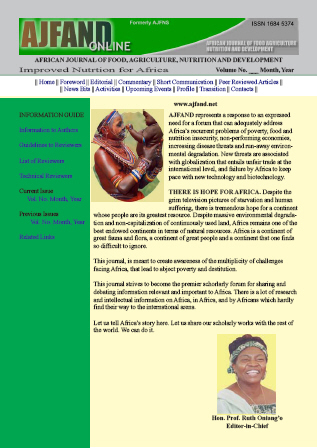
|
African Journal of Food, Agriculture, Nutrition and Development
Rural Outreach Program
ISSN: 1684-5358
EISSN: 1684-5358
Vol. 20, No. 6, 2020, pp. 16793-16809
|
 Bioline Code: nd20106
Bioline Code: nd20106
Full paper language: English
Document type: Research Article
Document available free of charge
|
|
|
African Journal of Food, Agriculture, Nutrition and Development, Vol. 20, No. 6, 2020, pp. 16793-16809
| en |
EXPOSURE OF SCHOOL CHILDREN TO AFLATOXINS AND FUMONISINS THROUGH MAIZE-BASED DIETS IN SCHOOL MEALS PROGRAMME IN SALIMA DISTRICT, MALAWI
Jere, GM; Abong’, GO; Njue, LG; Masamba, K & Omayio, DG
Abstract
Exposure to aflatoxins and fumonisins contaminated food poses threats to human health,
including causation of cancer, immunosuppression, impaired growth, respiratory
problems, diarrhea, among others. This study was carried out to evaluate the levels of
aflatoxins and fumonisins in maize-based porridge and the estimated intake levels of the
contaminants among school going children in selected primary schools in Salima
District, Malawi. A total of 496 children and 124 food handlers from 31 primary schools
within three Extension Planning Areas (EPAs) under the School Meals Programmes were
involved. Consumption and meal preparation data were collected from the respondents
using pre-tested questionnaires. Reveal Q+ Kits were used to quantify aflatoxins and
fumonisins in sampled meals. Monte Carlo risk simulation using @RiskPalisade
software (UK) was used to generate exposure data. All porridge samples had varying
detectable levels of mycotoxins. However, there were no significant (P < 0.05)
differences in the aflatoxins and fumonisins levels for samples from different EPAs
indicating the endemic presence of mycotoxins within the district. Over 95% of the
schools used maize as the main ingredient in preparing the porridge with relatively high
quantities consumed 610 grams/child/day equivalent to 0.019 kg/kg bodyweight/day
regardless of the gender (χ2 = 5.624, P = 0.286) or the age (r = 0.033, P = 0.459) of the
respondents. The levels of aflatoxins and fumonisins in the samples ranged from 2.13 to
33.37 μg/kg and < 0.3 to 1.0 ng/kg, respectively. The mean and the 95th percentile intake
levels for aflatoxins ranged from 0.2 - 0.60 ng/kg bodyweight/day and 6 – 9.2 μg/kg
bodyweight/day for fumonisins, which exceeded the recommended safety levels for
children according to standards of European Food Safety Authority (2007) and Joint
Food and Agriculture Organization/World Health Organization Committee on Food
Additives (2008), respectively. The consumption of maize-based porridge was found to
expose school-going children to unacceptable levels of mycotoxins whose effects on
their health, education and well-being remain unknown. There is a need to educate food
handlers on mycotoxins intoxication and proper postharvest handling practices of maize-based
foods to prevent exposure. Furthermore, diversification to reduce overreliance on
maize-based diets should be promoted.
Keywords
Aflatoxins; Fumonisins; Exposure; School children; School Meals; Maize-based-porridge
|
| |
© Copyright 2020 - African Journal of Food, Agriculture, Nutrition and Development
Alternative site location: http://www.ajfand.net/
|
|
